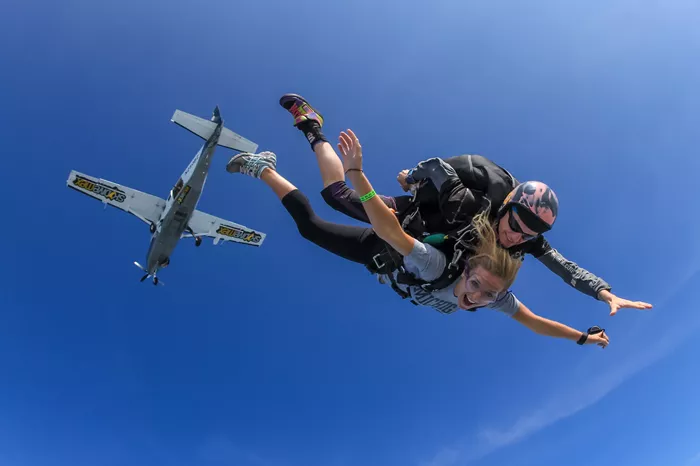Skydiving is a thrilling sport that combines the rush of freefall with the serenity of a parachute glide. For both novices and seasoned jumpers, understanding the safe speeds for skydiving is crucial for ensuring a safe and enjoyable experience. This article delves into the various aspects of skydiving speeds, including terminal velocity, factors affecting speed, safety considerations, and tips for maintaining control during a jump.
The Basics of Skydiving Speeds
What is Terminal Velocity?
Terminal velocity is the maximum speed that a skydiver can reach during freefall when the force of gravity is balanced by the resistance of the air. At this point, the skydiver stops accelerating and falls at a constant speed. For a belly-to-earth position, the most common freefall position, terminal velocity is typically around 120 mph (193 km/h).
Factors Influencing Skydiving Speeds
Several factors can influence the speed at which a skydiver falls:
Body Position: The most significant factor affecting freefall speed is the skydiver’s body position. A belly-to-earth position creates more air resistance, resulting in a slower fall. Conversely, a head-down position reduces air resistance and increases speed, often reaching terminal velocities of 150-180 mph (240-290 km/h).
Body Mass: Heavier skydivers fall faster than lighter ones due to the increased gravitational force acting on their bodies.
Altitude: Higher altitudes can result in higher freefall speeds due to thinner air and reduced air resistance. However, the difference is often negligible for standard skydiving altitudes.
Clothing and Gear: The type and fit of a skydiver’s jumpsuit and gear can affect air resistance. Streamlined suits designed for speed skydiving can significantly increase freefall speed.
Safety Considerations for Skydiving Speeds
Maintaining Control During Freefall
Maintaining control during freefall is essential for a safe skydiving experience. Skydivers must be able to adjust their body position to control their fall rate and direction. Proper training and experience are crucial for mastering these skills. Here are some tips for maintaining control:
Practice Body Positioning: Regular practice in a wind tunnel can help skydivers refine their body positions and learn to control their fall rate effectively.
Stay Relaxed: Tension can lead to instability. Skydivers should stay relaxed and make smooth, deliberate movements to maintain control.
Use Visual Cues: Keeping an eye on the horizon and using visual cues can help skydivers maintain a stable position and orientation during freefall.
Understanding the Importance of Parachute Deployment
Deploying the parachute at the right time and speed is critical for a safe landing. Most skydivers deploy their parachutes between 2,500 and 5,000 feet above the ground. At this altitude, the freefall speed is typically around 120 mph, which is safe for parachute deployment. Deploying the parachute at higher speeds can lead to a more forceful opening, which can cause injury or equipment damage.
Advanced Skydiving Techniques and Speed Control
Speed Skydiving
Speed skydiving is a competitive discipline where skydivers aim to achieve the highest possible speeds during freefall. Participants typically use a head-down position to minimize air resistance and maximize speed. The current world record for speed skydiving is over 300 mph (483 km/h).
Tracking and Angle Flying
Tracking and angle flying are techniques used to move horizontally across the sky during freefall. These techniques involve adjusting the body position to create a forward glide, which can help skydivers cover more distance and avoid obstacles. Proper training and experience are essential for mastering these techniques.
Equipment and Gear for Safe Skydiving
Jumpsuits and Helmets
The choice of jumpsuit can significantly impact freefall speed and control. Streamlined suits designed for speed skydiving reduce air resistance, while suits with more drag are used for slower, more controlled falls. Helmets provide essential protection and often include features like audible altimeters to help skydivers monitor their altitude.
Parachutes and AADs
Modern parachutes are designed for safety and reliability. Main parachutes are packed for easy deployment, while reserve parachutes provide a backup in case of a malfunction. Automatic Activation Devices (AADs) are electronic devices that automatically deploy the reserve parachute if the skydiver fails to do so at a safe altitude.
see also: How Many Times Do You Have To Skydive To Base Jump
Training and Preparation for Safe Skydiving
Skydiving Courses and Certifications
Proper training is essential for safe skydiving. Skydivers should complete a certified training program that includes both ground school and in-air instruction. Organizations like the United States Parachute Association (USPA) offer comprehensive training programs and certifications.
Physical and Mental Preparation
Skydiving requires both physical and mental preparation. Skydivers should maintain good physical fitness to handle the physical demands of the sport. Mental preparation is equally important, as skydivers must remain calm and focused during the jump.
Conclusion
Understanding and controlling freefall speeds are crucial for a safe and enjoyable skydiving experience. By maintaining proper body positioning, deploying the parachute at the right time, and using the right equipment, skydivers can ensure their safety and maximize their enjoyment of this exhilarating sport. Whether you are a novice or an experienced skydiver, always prioritize safety and continuous learning to make the most of your skydiving adventures.
related topics:
- What Are The Long Term Effects Of Skydiving
- What To Avoid Before Skydiving?
- How Hard Is It To Breathe While Skydiving?

